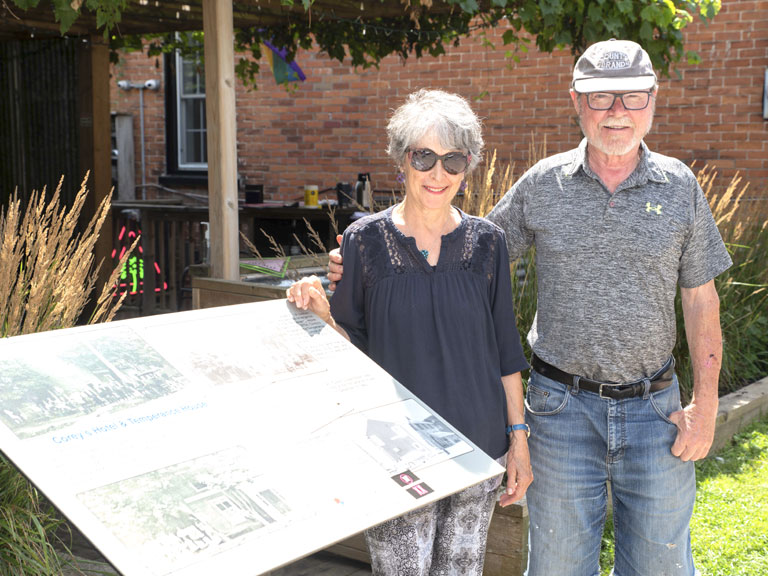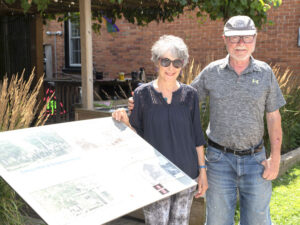County News
Bloomfield history panels

New interpretive panels depict Bloomfield settlement
At one time, the village of Bloomfield— then known as Bull’s Mills— was home to four mills that took their power from two creeks running through the village. Those mills fuelled Bloomfield’s growth, as farmers brought their grain to be ground or their logs to be sawn into lumber. Hotels and other businesses sprang up to fill the need, and soon houses and shops filled Main Street, giving it a character that lasts to the present day. The village was home to many Quaker families in the early 1800s, and their influence is seen in a number of the houses that grace both sides of Main Street, with simple, clean lines and subdued exterior decoration. At one time there were two Quaker meeting houses and two Quaker graveyards that were established in the early 1800s. This rich history and other developments up to the mid-1900s are now depicted on eight interpretive history panels at specific sites considered to be important to Bloomfield’s growth as a village. A ninth panel displaying a map of the village and the location of the other panels is scheduled to be installed beside Bloomfield Town Hall.

Barbara McMullen and Rob Leek stand beside one of the history panels recently installed in the village of Bloomfield.
The history panel project was made possible through funding from the Prince Edward County Downtown Revitalization Initiative, and was completed with the support of the Bloomfield and Area Business Association (BABA). “The Business Association met to say there are some funds available, what do you want to do with them? And there were three ideas that came out at that meeting at Saylor House, and they said this was the most attractive idea that the funds should be invested to produce panels to give visitors—and our own people—a sense of the history of our community, and to be an attraction for the people who stroll the streets of Bloomfield,” said Rob Leek, past president of BABA. One of the leaders in this project was Barbara McMullen, who did the research to provide the information on the panels. “I think it is really important to document the growth of the settlement of Bloomfield from its early years, which started in the late 1700s, and through the 1800s and into the 1900s,” she said. “I think Bloomfield is unique in terms of many other towns in Ontario in that its physical characteristics are still pretty much intact. The panels introduce information about some of the existing buildings that are here and how some of the businesses have evolved through time in those buildings. The panel on Mill Street talks about the four early mills that were present in Bloomfield and really catalyzed the growth. And there’s the Quaker settlement that was very large and ran all the way down to East Lake and westward to Wellington. It was two Quaker families that settled here, the Bowermans and the Bulls, and they had come from Dutchess County in New York.” Other plaques describe the canning industry in Bloomfield, the railway station, the cheese factory and a number of significant buildings.
Steve Campbell adds that it is important to showcase the history of the village. “The history all over the County is of interest to everyone, not just the people who have lived here, grown up here and have several generations behind them, but to a lot of the new people who are moving in to areas like ours, particularly Bloomfield,” he said. “They want to know who owned the house, who built the house, all the details. They want to know if there are photographs of it in the early stage. A lot of people who come from the city and buy houses here really want to restore them to what they looked like in the 1800s. For example, they’ll tear off porches or add porches and porticos to try to bring it back to its original form. So there’s wide general interest in everybody to find details of the past. It’s like a jigsaw puzzle. The more little pieces they find, it just makes them feel great.”
Information on the plaques was gathered from a number of sources, including the Prince County Archives and the Pictorial History of Bloomfield compiled by resident Dorothy Fraleigh. “The history panels, along with the brochure Heritage Walks in Bloomfield tell the story behind the ‘faces’ of many existing buildings and important sites in Bloomfield, enriching the experience of the village, not only for visitors, but for the residents of Prince Edward County,” said Barbara McMullen. “The panels tell the story of Bloomfield as the centre of Quakerism in Prince Edward County by virtue of its early settlement of the Society of Friends who migrated here after the end of the American Revolution. They also describe the four early mills, along with important hotels, factories and businesses, such as the cheese factory and the many canning companies. The panels also describe the role of two important building contractors, William DeGroffe and Adam Saylor, in shaping the red brick architectural character of many of Bloomfield’s existing buildings.”

Who were the early builders of main St. Red brick buildings? So many and I think he was 11 when he apprenticed as a carpenter and unpaid till he was in his 20’s.